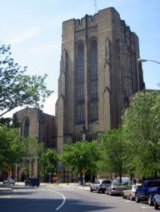
Payne Whitney Gymnasium
Encyclopedia
The Payne Whitney Gymnasium is the gymnasium
of Yale University
. Built in the prevailing Gothic architecture
style of the campus in 1932, it is a remarkable building, possessing a Gothic tower, a third-floor swimming pool
, a polo
practice room, and a rooftop running track. It is the second-largest gym in the world. The building houses the facilities for the basketball, fencing, gymnastics, squash, swimming, and volleyball teams.
The building was donated to Yale by John Hay Whitney
, of the Yale class of 1926, in honor of his father, Payne Whitney. One myth holds that Mrs. Payne Whitney wanted Yale to build a great cathedral with her money, but that the University preferred a gym. Since she was getting old, the story goes, administrators thought they could get away with a bit of fraud. They instructed architect John Russell Pope
to design a gym that could pass for a cathedral. Then, when it was completed, the President drove Mrs. Whitney past the finished building. She died not long after, content in the knowledge that she had given Yale such a grand house of worship, and not what came to be known as "the cathedral of sweat."
For the design of Payne Whitney Gymnasium, architect John Russell Pope was awarded the Silver Medal at the 1932 Olympic Games Art Competition
.
The stuffed
original Handsome Dan, the bulldog
mascot
of Yale and the first college mascot in the United States, resides in a glass cabinet near the entrance to the building.
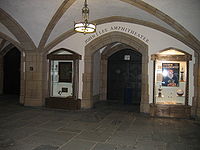
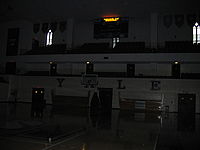
Exhibition Pool (6 lanes, 25 yards), where the swimming teams compete. The pool is named for Yale's legendary swimming coach and athletic director.
A series of three crew tanks runs along the back of the gym, providing training facilities for the crews. Above the crew tanks is the Practice Pool, one of the world's largest suspended natatoriums (5 lanes, 50 meters, 2 bulkheads). Above the Practice Pool are recreational basketball courts.
On the wings, the Adrian "Ace" Israel Fitness Center is located above the Kiphuth Exhibition Pool, and the Brady Squash Center is located above the Amphitheater. The Squash Center, one of the world's premier competition facilities, is also home to the U.S. Squash
Hall of Fame. The roof of the Squash Center has a small outdoor running track.
The tower itself contains the Kiphuth Trophy Room (where mementos from Harvard-Yale game balls to Olympic gold medals are displayed), several multi-purpose recreational areas, the fencing salon, and the gymnastics studio.
The newly-built Lanman Center, located behind the Amphiteater wing, provides a vast spread of additional flexible floor space, with a balcony running track ringing the facility.
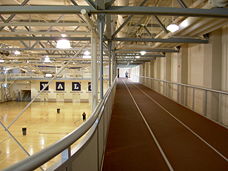 The William K. Lanman
The William K. Lanman
Center was added in 1999 as a new wing, with additional courts for basketball and volleyball, and an indoor running track. This was the first phase of a $100 million renovation program.
In 2006, the building is having external work done to repair flashing and stop leaks. Other work includes the purchasing of banners and benches for the Kiphuth Exhibition Pool, the resurfacing of the floor in the Lee Amphitheater, and the upgrading of the Practice Pool's filtration system (see Pool Closure below).
The pool reopened on November 27, 2006 after the installation of an ultraviolet filter, which has greatly improved the water quality (and consequently the air quality). See Yale Daily News article
Gym
The word γυμνάσιον was used in Ancient Greece, that mean a locality for both physical and intellectual education of young men...
of Yale University
Yale University
Yale University is a private, Ivy League university located in New Haven, Connecticut, United States. Founded in 1701 in the Colony of Connecticut, the university is the third-oldest institution of higher education in the United States...
. Built in the prevailing Gothic architecture
Gothic architecture
Gothic architecture is a style of architecture that flourished during the high and late medieval period. It evolved from Romanesque architecture and was succeeded by Renaissance architecture....
style of the campus in 1932, it is a remarkable building, possessing a Gothic tower, a third-floor swimming pool
Swimming pool
A swimming pool, swimming bath, wading pool, or simply a pool, is a container filled with water intended for swimming or water-based recreation. There are many standard sizes; the largest is the Olympic-size swimming pool...
, a polo
Polo
Polo is a team sport played on horseback in which the objective is to score goals against an opposing team. Sometimes called, "The Sport of Kings", it was highly popularized by the British. Players score by driving a small white plastic or wooden ball into the opposing team's goal using a...
practice room, and a rooftop running track. It is the second-largest gym in the world. The building houses the facilities for the basketball, fencing, gymnastics, squash, swimming, and volleyball teams.
The building was donated to Yale by John Hay Whitney
John Hay Whitney
John Hay Whitney , colloquially known as "Jock" Whitney, was U.S. Ambassador to the United Kingdom, publisher of the New York Herald Tribune, and a member of the Whitney family.-Family:...
, of the Yale class of 1926, in honor of his father, Payne Whitney. One myth holds that Mrs. Payne Whitney wanted Yale to build a great cathedral with her money, but that the University preferred a gym. Since she was getting old, the story goes, administrators thought they could get away with a bit of fraud. They instructed architect John Russell Pope
John Russell Pope
John Russell Pope was an architect most known for his designs of the National Archives and Records Administration building , the Jefferson Memorial and the West Building of the National Gallery of Art in Washington, DC.-Biography:Pope was born in New York in 1874, the son of a successful...
to design a gym that could pass for a cathedral. Then, when it was completed, the President drove Mrs. Whitney past the finished building. She died not long after, content in the knowledge that she had given Yale such a grand house of worship, and not what came to be known as "the cathedral of sweat."
For the design of Payne Whitney Gymnasium, architect John Russell Pope was awarded the Silver Medal at the 1932 Olympic Games Art Competition
Art competitions at the 1932 Summer Olympics
Art competitions were held as part of the 1932 Summer Olympics in Los Angeles, United States. Medals were awarded in five categories , for works inspired by sport-related themes....
.
The stuffed
Taxidermy
Taxidermy is the act of mounting or reproducing dead animals for display or for other sources of study. Taxidermy can be done on all vertebrate species of animals, including mammals, birds, fish, reptiles, and amphibians...
original Handsome Dan, the bulldog
Bulldog
Bulldog is the name for a breed of dog commonly referred to as the English Bulldog. Other Bulldog breeds include the American Bulldog, Olde English Bulldogge and the French Bulldog. The Bulldog is a muscular heavy dog with a wrinkled face and a distinctive pushed-in nose...
mascot
Mascot
The term mascot – defined as a term for any person, animal, or object thought to bring luck – colloquially includes anything used to represent a group with a common public identity, such as a school, professional sports team, society, military unit, or brand name...
of Yale and the first college mascot in the United States, resides in a glass cabinet near the entrance to the building.


Facilities
The basketball team plays in the John J. Lee Amphitheater, which was named in 1996 for John J. Lee, '56 M.Eng., a star basketball player and benefactor in restoration projects; the volleyball and gymnastics teams also compete in the Amphiteater. The wing opposite the Amphiteater houses the Robert J. H. KiphuthRobert J. H. Kiphuth
Robert John Herman Kiphuth was born in Tonawanda, New York and is best known for his 42-year career as head coach of the Yale University men's swim team, from 1917-1959...
Exhibition Pool (6 lanes, 25 yards), where the swimming teams compete. The pool is named for Yale's legendary swimming coach and athletic director.
A series of three crew tanks runs along the back of the gym, providing training facilities for the crews. Above the crew tanks is the Practice Pool, one of the world's largest suspended natatoriums (5 lanes, 50 meters, 2 bulkheads). Above the Practice Pool are recreational basketball courts.
On the wings, the Adrian "Ace" Israel Fitness Center is located above the Kiphuth Exhibition Pool, and the Brady Squash Center is located above the Amphitheater. The Squash Center, one of the world's premier competition facilities, is also home to the U.S. Squash
U.S. Squash
U.S. Squash is the national governing body for the sport of squash in the United States. U.S. Squash was previously known as the United States Squash Racquets Association . The organization is headquartered in New York City and is a member of the U.S. Olympic Committee. U.S. Squash owns and...
Hall of Fame. The roof of the Squash Center has a small outdoor running track.
The tower itself contains the Kiphuth Trophy Room (where mementos from Harvard-Yale game balls to Olympic gold medals are displayed), several multi-purpose recreational areas, the fencing salon, and the gymnastics studio.
The newly-built Lanman Center, located behind the Amphiteater wing, provides a vast spread of additional flexible floor space, with a balcony running track ringing the facility.
Renovation
 | 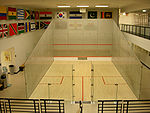 | 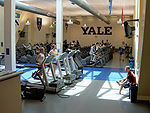 | 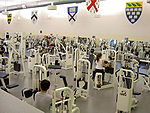 |

William K. Lanman
Colonel William Kelsey Lanman Jr., was a notable benefactor of Yale University. He served as an aviator in the United States Marine Corps from 1935 to 1955, and later took up real estate and investment management....
Center was added in 1999 as a new wing, with additional courts for basketball and volleyball, and an indoor running track. This was the first phase of a $100 million renovation program.
In 2006, the building is having external work done to repair flashing and stop leaks. Other work includes the purchasing of banners and benches for the Kiphuth Exhibition Pool, the resurfacing of the floor in the Lee Amphitheater, and the upgrading of the Practice Pool's filtration system (see Pool Closure below).
Pool closure
On Friday October 27, 2006 Yale University closed the third floor practice pool over health concerns due to poor maintenance and outdated filtration and ventilation equipment. See the Yale Daily News article.The pool reopened on November 27, 2006 after the installation of an ultraviolet filter, which has greatly improved the water quality (and consequently the air quality). See Yale Daily News article

